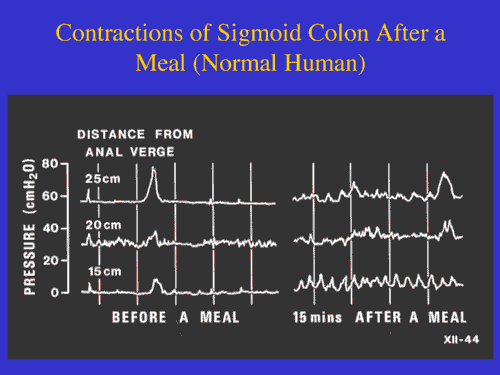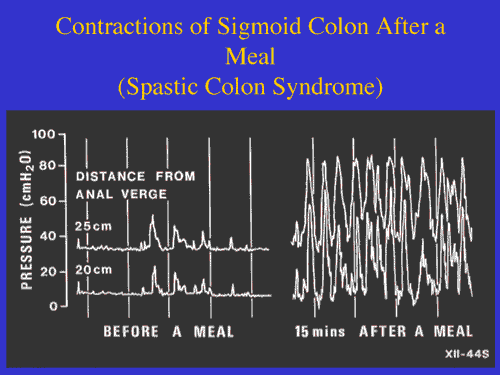See What an IBS Attack Looks Like
Irritable Bowel Syndrome, as defined by the Rome Criteria diagnostic guidelines, is characterized as a brain-gut dysfunction. What on earth does this mean?
In plain English, it means that IBS symptoms result from a hypersensitivity of the nervous system of the gut, along with misinterpretations of the nervous system messages from the gut by the central nervous system and the brain.
Basically, this circuit (from gut to brain and brain to gut) appears to be abnormal in patients with Irritable Bowel Syndrome, though the exact abnormalities remain unclear.
Remarkably, PET scans of the brains of people with IBS show pronounced differences in the activation of certain parts of the brain relating to perception and pain (versus normal individuals). MRI brain scans have shown similar results.
This means that IBS is indisputably a physical problem. Simply put, the brain-gut interaction of people with IBS influences their bowel pain perception and motility. In a nutshell, the processing of pain information within the central nervous system varies between normal individuals and those of us with IBS, with the result that we can experience even normal GI contractions as painful.
The interactions between our brains, central nervous systems, and GI systems are just not functioning properly. We have colons that react to stimuli that do not affect normal colons, and our reactions are much more severe.
The end result is heightened pain sensitivity and abnormal gut motility, in the form of irregular or increased GI muscle contractions. It is this gut overreaction and altered pain perception that cause the lower abdominal cramping and accompanying diarrhea and/or constipation that characterize IBS.
However, while the underlying problem might well be in our brains, there is still a physical abnormality in the way our colons function. This dysfunction is actually visible (shockingly so) in the medical imaging tests below.

This is a normal gut 15 minutes after a meal.

This is an IBS gut 15 minutes after a meal. Holy cow!
Images from Irritable Bowel Syndrome (IBS): Examining New Findings and Treatments. Authors: Marvin M. Schuster, MD; Michael D. Crowell, PhD; Nicholas J. Talley, MD, PhD. Continuing Medical Education Activity, Johns Hopkins School of Medicine, October 26, 2000, via Medscape. Used with permission.
Typically, the majority of the time the colon is still. However, following a meal, the stomach triggers something called the gastrocolic reflex. This response occurs when food passes from the stomach into the upper part of the small intestine.
Normally, the gastrocolic reflex causes periodic contractions of the colon at different points along its length, at timed intervals. These segmented contractions regulate the flow of waste, and keep it in contact with the bowel wall, allowing water to be absorbed.
Finally, peristaltic contractions of the colon propel the waste to the rectum and then out of the anus via evacuation by a bowel movement. Total average transit time through the entire 30-foot digestive system, from mouth to anus, is between 12-24 hours for healthy individuals with high-fiber diets, and 48-72 hours for most Americans eating a typical Western (high fat/animal protein, low fiber) diet.
Where Things Go Wrong...
Unfortunately, how the digestive tract is supposed to work is not exactly how it does work for those of us with IBS. The key problem seems to be with the gastrocolic reflex. Specifically, research has found that many IBS patients have highly abnormal ones.
Our colons have disorganized and significantly more violent and prolonged contractions (leading to diarrhea), or almost no contractions at all (resulting in constipation).
Amazingly, researchers have found that while healthy people have between 6-8 peristaltic contractions in their colon within a 24-hour period, IBS sufferers with diarrhea have as many as 25 peristaltic contractions per day, and constipation-prone IBS patients have almost none.
Add to this bowel dysfunction the heightened pain perception resulting from our abnormal brain-gut interactions, and you've got the recipe for disaster...spelled I-B-S.
There's vivid demonstration of this in the images above. They show the huge difference between the after-meal contractions of a normal person's lower (sigmoid) colon and the contractions of the lower (sigmoid) colon in a person with IBS. The left half of both illustrations shows the colon contractions before a meal, and the rates are very similar and quite modest.
Just fifteen minutes after eating, however, the differences in colon contractions as shown on the right sides of the graphics are dramatic. Given the almost off-the-chart severity of the spasms (measured by the vertical axis in terms of pressure) in the IBS patient, it's easy to literally see exactly why the pain and bowel dysfunctions of this disorder can be so extreme.
As you read these graphics, don't be intimidated by the "distance from anal verge"legend for the horizontal axis of the chart. All that term basically means is how far up into the colon from the anus the contractions are being measured (they're either 15, 20, or 25 centimeters up into the colon from the outside of the anus).
In other words, the contractions triggered by the gastrocolic reflex from the stomach are affecting the very lower end of the colon just fifteen minutes after a meal has been eaten. This gives a crystal clear explanation for how an attack can hit you so fast and so hard after - or even while - eating.
Personally, I can't look at these charts without having flashbacks to all the times I've had to rush from the dinner table before I'd even finished my meal. The worst memory of all is from a vacation in Hawaii when I was twelve, and had been allowed to order a whole lobster for myself.
Unfortunately, a virgin pina colada (in hindsight, it was the high-fat coconut milk on an empty stomach that did me in) triggered an attack before my meal had even arrived at the table. I spent the entire evening doubled over in agony in a bright pink hotel ladies lounge while my family ate my lobster.
It's not much consolation to finally get a scientific explanation for exactly what happened to me that night, but I suppose it's nice to no longer be completely in the dark. (And in case you're wondering, I haven't had a pina colada since.)
No one really yet knows exactly why some people develop the brain-gut dysfunction of IBS and others don't. There is mounting evidence that for some IBS sufferers the condition is precipitated by some type of grievous insult to the gut - dysentery, food poisoning, intestinal flu, abdominal surgery, even pregnancy. The theory goes that even after full physical recovery from these traumatic events, the nerves within the gut retain a "memory" of the insult and remain hyper-sensitive to further stimulation, as well as prone to subsequent over-reaction.
You likely know if you experienced any abdominal trauma immediately prior to the onset of your IBS symptoms, and if you did it's probably nice to have a logical explanation for what has happened to your GI tract and why. There are those of us who are exceptions to this theory, however, who suffered no gut insult prior to the onset of IBS symptoms, and we're still patiently waiting for our explanation.
So now that you know it's a brain-gut connection that's going wrong with your body, what can you do about it?
My top recommendation is gut-directed hypnotherapy. It's one of the most promising methods of treating IBS permanently (researchers have actually called it a cure!), and it deals specifically with the brain-gut dysfunction.
To manage symptoms on a daily basis, a prebiotic soluble fiber supplement can help regulate the gastrocolic reflex, and keep peristalsis normal. This can prevent abdominal spasms and cramps, and relieve both diarrhea and constipation.
To learn more about the brain-gut dysfunction and Irritable Bowel Syndrome overall, check the The First Year: IBS, an essential guide to successfully managing the disorder.
Finally, there are numerous published medical studies on the IBS brain-gut dysfunction in the IBS Research Library.
Brain-gut dysfunction information excerpted from The First Year: IBS, copyright Heather Van Vorous.
